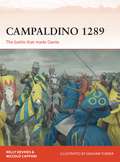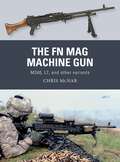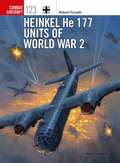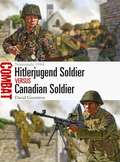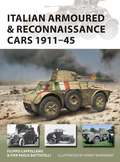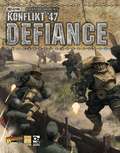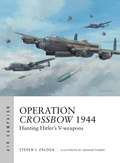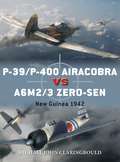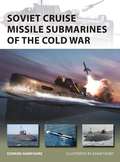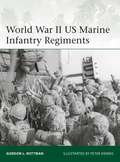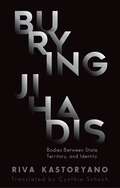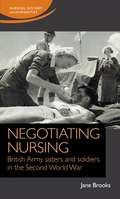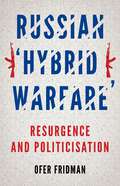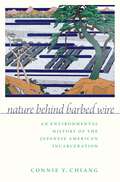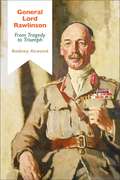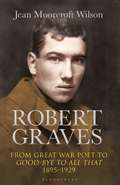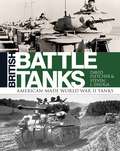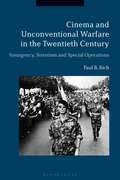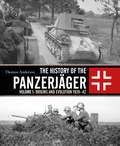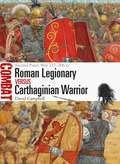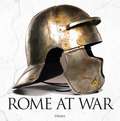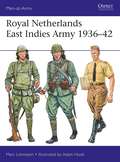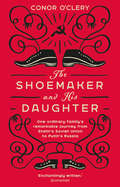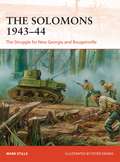- Table View
- List View
Campaldino 1289: The battle that made Dante (Campaign)
by Graham Turner Bounford.com Bounford.com Paul Kime Kelly DeVries Niccolò CapponiCampaldino is one of the important battles between the Guelphs and Ghibellines - the major political factions in the city states of central and northern Italy. It heralded the rise of Florence to a dominant position over the area of Tuscany and was one of the last occassions when the Italian city militias contested a battle, with the 14th century seeing the rise of the condottiere in Italy's Wars.In this highly illustrated new study, renowned medieval historians Kelly De Vries and Niccolò Capponi have uncovered new material from the battlefield itself, as well as using all the available sources, to breathe new life into this colourful and fascinating battle.
The FN MAG Machine Gun: M240, L7, and other variants (Weapon)
by Johnny Shumate Chris McNab Alan GillilandFor six decades, the 7.62mm FN MAG has been a dominant general-purpose machine gun (GPMG) in worldwide arsenals. Three qualities have guaranteed this enduring status – reliability, ease of operation, and firepower. Several nations have license-produced the weapon as their standard GPMG, including the British (as the L7) and the Americans (M240), and in total more than 80 nations have adopted the FN MAG. The machine gun has also been modified extensively for vehicular, naval, and aircraft platforms, demonstrating versatility in the air, on sea, and on land.In this book, Chris McNab charts the technical evolution of this extraordinary weapon, created by Belgian company Fabrique Nationale d'Herstal. From the jungles of South East Asia, to the deserts of the Middle East, and the icy battlefields of the Falklands, this study explores the origins, development, combat use, and legacy of the FN MAG machine gun, a dominant weapon in its field for more than a half-century.
Heinkel He 177 Units of World War 2 (Combat Aircraft #123)
by Jim Laurier Robert Forsyth Mark PostlethwaiteIn many ways, the Heinkel He 177 'Greif' (Griffon) was Nazi Germany's 'lost' strategic bomber. With some fundamental creases ironed out, and built in large numbers, the He 177 would have offered the Luftwaffe the means with which to carry out long-range, mass bombing attacks against targets of a strategic nature. Although competing interests and personalities served to prevent this from happening, from mid-1943 the aircraft nevertheless saw service over England, the Atlantic, the Mediterranean and in Russia. The He 177 flew to the end of the war, with some machines undertaking extremely hazardous low-level missions against Soviet armour in Poland in late 1944-45. This fascinating book, filled with detailed artwork and contemporary photographs, tells the story of this aircraft, including the political infighting at the top of the Luftwaffe's hierarchy that stymied its development, its radical technical design and its state-of-the-art weaponry.
Hitlerjugend Soldier vs Canadian Soldier: Normandy 1944 (Combat)
by Johnny Shumate David GreentreeCanadian and Waffen-SS troops of 12. SS-Panzer-Division Hitlerjugend faced one another in a series of bloody battles following the D-Day landings of June 1944. The Canadian units fought in a number of distinguished regiments, while the Hitlerjugend Division were drawn from the ranks of the Hitler Youth organizations. Veteran officers and NCOs were joined by inexperienced teenagers, and clashed with the Canadians repeatedly, notably at Authie, Bretteville and Hill 168. The struggle quickly took on an especially bitter nature, fuelled by the massacre of Canadian prisoners by Hitlerjugend personnel. Employing first-hand accounts and the latest research, as well as specially commissioned artwork and carefully selected archive photographs this absorbing study investigates the origins, ethos, training, fighting techniques and weapons of both sides during the epic struggle for Normandy.
Italian Armoured & Reconnaissance Cars 1911–45 (New Vanguard)
by Pier Paolo Battistelli Henry Morshead Filippo CappellanoThe first Italian armoured cars were used in the war in Libya in 1911-12 against the Ottoman Empire. With few tanks being developed, the Italians relied instead on the development of more mobile armoured cars like the Ansaldo Lancia 1 Z, during World War I, but post-war the army, focusing on the Alpine battlegrounds of Italy's northern borders, did not consider armoured cars suitable for reconnaissance duties. The experience of the Spanish Civil War would provide the much needed last push for the Italians to develop modern armoured cars. The result were the famous AB 41-43 models, which fought against the British in North Africa and Marshall Tito's forces in Yugoslavia, along with other vehicles such as the AS 36 light armoured car.Using detailed colour plates and contemporary photographs, this book examines the development of the Italian armoured car in the two world wars and the inter-war years, from the deserts of North Africa to the slopes of the Alps.
Konflikt '47: Defiance (Bolt Action)
by Warlord Games Clockwork Goblin Peter DennisDelving deeper into the weird world of Konflikt '47, this supplement presents a range of new material for the game, including: - New units: Options for troops and technology that can be added to the armies presented in the rulebook. - Special characters: Field the best of the best, elite men and women who may singlehandedly be the crucial element between victory and defeat. - New background: The history of the world of Konflikt '47 is detailed in more depth. - New rules: All-new means of waging war, including material previously published online.
Operation Crossbow 1944: Hunting Hitler's V-weapons (Air Campaign #5)
by Steven J. Zaloga Graham Turner Adam Tooby Bounford.com Bounford.com Paul KimeIn mid-1943, Allied intelligence began to pick up the signs of unusual German construction in remote locations near the Channel Coast. Several massive fortifications were beginning to take shape, and they appeared to be oriented towards London. Allied intelligence codenamed these sites as "Crossbow" and began plans to attack them before they could bombard Britain's capital city. These "Heavy Crossbow" sites for the V-1 and V-2 missiles were supposed to be bomb-proof, but they soon attracted the attention of RAF heavy bombers with the new Tallboy concrete-penetrating bombs. Fully illustrated with commissioned artwork and contemporary photographs, Operation Crossbow 1944 examines the dynamics of the world's first missile war. It also describes the parallel American efforts to develop missiles and assault drones to attack the "Heavy Crossbow" sites, including the Air Force's Aphrodite and Navy Anvil projects.
P-39/P-400 Airacobra vs A6M2/3 Zero-sen: New Guinea 1942 (Duel #87)
by Jim Laurier Gareth Hector Michael John ClaringbouldAfter the huge advances made in the early months of the Pacific war, it was in remote New Guinea where the advance of Imperial Japanese Naval Air Force (IJNAF) A6M Zero-sen fighters was first halted due to a series of offensive and defensive aerial battles ranging from treetop height up to 30,000 ft. Initially, the IJNAF fought Australian Kittyhawks, but by May 1942 they had fought themselves into oblivion, and were relieved by USAAF P-39 and P-400 Airacobras. The battles unfolded over mountainous terrain with treacherous tropical weather. Neither IJNAF or USAAF pilots had been trained for such extreme conditions, incurring many additional losses aside from those that fell in combat. Using specially commissioned artwork and contemporary photographs and testimony, this fascinating study explains how, despite their initial deficit in experience and equipment, the Airacobras managed to square the ledger and defend New Guinea.
Soviet Cruise Missile Submarines of the Cold War (New Vanguard #260)
by Adam Tooby Edward HampshireThe Soviet Union's cruise missile submarines from the modified Whiskey, to the Oscar II classes were among the most formidable vessels of the Cold War. They were initially designed to carry land attack nuclear-tipped cruise missiles designed to strike targets on the eastern coast of the United States. By the late 1960s, however, submarine-launched ballistic missiles made the nuclear land-attack mission unnecessary, so existing classes were converted to the 'carrier killer' role, armed with anti-ship cruise missiles designed to destroy US super-carriers and other important naval targets. This fully illustrated study examines these powerful machines that were some of the largest and fastest submarines ever built. If war had broken out, they would have been at the forefront of the Soviet Navy's campaign to destroy NATO's sea power and cut America's sea link with Europe.
Valley of the Shadow: The Siege of Dien Bien Phu
by Kevin Boylan Luc OlivierStruggling to reassert control over their Indochinese colonies after World War II, the French established a huge air-land base in the valley of Dien Bien Phu. But when the opposing Vietnamese People's Army (VPA) began massing its forces against the base in late 1953, French commanders seized the opportunity to draw their elusive enemy into a decisive set-piece battle.Defending a series of fortified positions which were reliant upon a single airstrip – and later, risky and inaccurate airdrops – for reinforcement and resupply, the French troops quickly discovered that they had underestimated their enemy. In 56 days of costly close-quarters fighting, the VPA slowly dislodged the French from one strongpoint after another by developing novel tactics and accomplishing incredible feats of engineering.Drawing upon Vietnamese-language sources never previously employed in Western accounts of the siege, Valley of the Shadow is a dramatic re-telling of the climactic battle of the First Indochina War, the conflict that saw the French expelled from their former colony and set the stage for the “American War” in Vietnam.
World War II US Marine Infantry Regiments (Elite #222)
by Peter Dennis Gordon L. RottmanThe United States Marine Corps came into its own in the Pacific Islands campaign against Japan in World War II. From Guadalcanal to Okinawa, US Marines formed the tip of the spear as Allied forces sought to push the Japanese back to their Home Islands.This fascinating study tracks the deployments of the various Marine divisions throughout the war and explains their composition, but also goes deeper, to detail the individual regiments – the focus of the marines' identity and pride. It explains the organization of the Marine infantry regiment and its equipment, and how they evolved during the war. The marine infantryman's evolving uniforms, field equipment and weapons are illustrated throughout using specially commissioned artwork and detailed descriptions to produce a fitting portrait of the US military's elite fighting force in the Pacific.
Burying Jihadis: Bodies Between State, Territory, and Identity
by Riva KastoryanoWhat should states do with the bodies of suicide bombers and other jihadists who die while perpetrating terrorist attacks? This original and unsettling book explores the host of ethical and political questions raised by this dilemma, from (non-)legitimization of the 'enemy' and their cause to the non-territorial identity of individuals who identified in life with a global community of believers. Because states do not recognize suicide bombers as enemy combatants, governments must decide individually what to do with their remains. Riva Kastoryano offers a window onto this challenging predicament through the responses of the American, Spanish, British and French governments after the Al-Qaeda suicide attacks in New York, Madrid and London, and Islamic State's attacks on Paris in 2015. Interviewing officials, religious and local leaders and jihadists' families, both in their countries of origin and in the target nations, she has traced the terrorists' travel history, discovering unexpected connections between their itineraries and the handling of their burials. This fascinating book reveals how states' approaches to a seemingly practical issue are closely shaped by territory, culture, globalization and identity.
Negotiating nursing: British Army sisters and soldiers in the Second World War (Nursing History and Humanities)
by Jane BrooksNegotiating Nursing explores how the Queen Alexandra's Imperial Military Nursing Service (Q.A.s) salvaged their soldier-patients within the sensitive gender negotiations of what should and could constitute nursing work and where that work could occur. The book argues that the Q.A.s, an entirely female force during the Second World War, were essential to recovering men from the battlefield and for the war, despite concerns about women’s presence on the frontline. Using personal testimony the book maps the developments in nurses’ work as they created a legitimate space for themselves in war zones and established their position as the expert at the bedside. Yet, despite the acknowledgement of nurses’ vital role in the medical service, their position was gendered. As the women of Britain were returned to the home post-war, it was the military nurses’ womanhood that stymied their considerable skills from being transferred to the new welfare state.
Russian "Hybrid Warfare": Resurgence and Politicization
by Ofer FridmanDuring the last decade, 'Hybrid Warfare' has become a novel yet controversial term in academic, political and professional military lexicons, intended to suggest some sort of mix between different military and non-military means and methods of confrontation. Enthusiastic discussion of the notion has been undermined by conceptual vagueness and political manipulation, particularly since the onset of the Ukrainian Crisis in early 2014, as ideas about Hybrid Warfare engulf Russia and the West, especially in the media. Western defense and political specialists analyzing Russian responses to the crisis have been quick to confirm that Hybrid Warfare is the Kremlin's main strategy in the twenty-first century. But many respected Russian strategists and political observers contend that it is the West that has been waging Hybrid War, Gibridnaya Voyna, since the end of the Cold War. In this highly topical book, Ofer Fridman offers a clear delineation of the conceptual debates about Hybrid Warfare. What leads Russian experts to say that the West is conducting a Gibridnaya Voyna against Russia, and what do they mean by it? Why do Western observers claim that the Kremlin engages in Hybrid Warfare? And, beyond terminology, is this something genuinely new?
Nature Behind Barbed Wire: An Environmental History of the Japanese American Incarceration
by Connie Y. ChiangThe mass imprisonment of over 110,000 people of Japanese ancestry during World War II was one of the most egregious violations of civil liberties in United States history. Removed from their homes on the temperate Pacific Coast, Japanese Americans spent the war years in desolate camps in the nation's interior. Photographers including Ansel Adams and Dorothea Lange visually captured these camps in images that depicted the environment as a source of both hope and hardship. And yet the literature on incarceration has most often focused on the legal and citizenship statuses of the incarcerees, their political struggles with the US government, and their oral testimony. Nature Behind Barbed Wire shifts the focus to the environment. It explores how the landscape shaped the experiences of both Japanese Americans and federal officials who worked for the War Relocation Authority (WRA), the civilian agency that administered the camps. The complexities of the natural world both enhanced and constrained the WRA's power and provided Japanese Americans with opportunities to redefine the terms and conditions of their confinement. Even as the environment compounded their feelings of despair and outrage, the incarcerees also found that their agency in transforming and adapting to the natural world could help them survive and contest their incarceration. Japanese Americans and WRA officials negotiated the terms of confinement with each other and with a dynamic natural world. Ultimately, as Connie Chiang demonstrates, the Japanese American incarceration was fundamentally an environmental story.
General Lord Rawlinson: From Tragedy to Triumph (Bloomsbury Studies in Military History)
by Rodney AtwoodIn this biography Rodney Atwood details the life of General Lord Rawlinson of Trent (1864-1925), a distinguished British soldier whose career culminated in decisive victories on the Western Front in 1918 and command of the Indian Army in the early 1920s. He served his soldier's apprenticeship in the Victorian colonial wars in Burma, the Sudan and South Africa. His career provides a lens through which to examine the British Army in the late-19th and early-20th century. In the South African War (1899-1902) Rawlinson's ideas aided the defence of Ladysmith, and he distinguished himself leading a mobile column in the guerrilla war. In the First World War he held an important command in most of the British Expeditionary Force's battles on the Western Front. He bears a heavy part-responsibility for the disastrous first day of the Somme, but later in the battle his successful tactics inflicted heavy losses on the enemy. His Western Front career culminated in a series of victories beginning at Amiens. He commanded the Indian Army between 1920 and 1925 at a time of military and political tension following the 3rd Afghan War and the Amritsar Massacre. He introduced necessary reforms, cut expenditure at a time of postwar retrenchment and began commissioning Indians to replace British officers. He would have taken up the post of CIGS (Chief of the Imperial General Staff), thus being the only British soldier to hold these two top posts. He died, however, four days after his sixty-first birthday. Drawing extensively on archival material including Rawlinson's own engagingly-written letters and diaries, this thorough examination of his life will be of great interest to those studying British military history, imperial history and the First World War.
Robert Graves: From Great War Poet to Good-bye to All That (1895-1929)
by Jean Moorcroft WilsonThe writer and poet Robert Graves suppressed virtually all of the poems he had published during and just after the First World War. Until his son, William Graves, reprinted almost all the Poems About War in 1988, Graves's status as a 'war poet' seems to have depended mainly on his prose memoir (and bestseller), Good-bye to All That. None of the previous biographies written on Graves, however excellent, attempt to deal with this paradox in any depth. Robert Graves the war poet and the suppressed poems themselves have been largely neglected – until now. Jean Moorcroft Wilson, celebrated biographer of poets Siegfried Sassoon, Isaac Rosenberg and Edward Thomas, relates Graves's fascinating life during this period, his experiences in the war, his being left for dead at the Battle of the Somme, his leap from a third-storey window after his lover Laura Riding's even more dramatic jump from the fourth storey, his move to Spain and his final 'goodbye' to 'all that'. In this deeply-researched new book, containing startling material never before brought to light, Dr Moorcroft Wilson traces not only Graves's compelling life, but also the development of his poetry during the First World War, his thinking about the conflict and his shifting attitude towards it. Robert Graves: From Great War Poet to Good-bye to All That casts new light on the life, prose and poetry of Graves, without which the story of Great War poetry is incomplete.
British Battle Tanks: American-made World War II Tanks
by David Fletcher Steven J. ZalogaThe idea of British soldiers using American tanks was not viewed with a great deal of enthusiasm by the British Army. They perceived American tanks as being crudely made, mechanically unsophisticated and impossible to fight in. However, once British crews got used to them and learned to cope with some of their difficulties, such as limited fuel capacity and unfamiliar fighting techniques, they started to see them in a far more positive light, in particular their innate reliability and simplicity of maintenance. This book, the last in a three-part series on British Battle Tanks by armour expert David Fletcher, concentrates on World War II and studies American tanks in British service, some of which were modified in ways peculiar to the British. It shows how the number of these tanks increased to the point that they virtually dominated, as well describing some types, such as the T14 and M26 Pershing, which were supplied but never used in British service.
Cinema and Unconventional Warfare in the Twentieth Century: Insurgency, Terrorism and Special Operations
by Paul B. RichCinematic representations of unconventional warfare have received sporadic attention to date. However, this pattern has now begun to change with the rise of insurgency and counter-insurgency in Iraq and Afghanistan, and the growing importance of jihadist terrorism in the wake of 9/11. This ground-breaking study provides a much-needed examination of global unconventional warfare in 20th-century filmmaking, with case studies from the United States, Britain, Ireland, France, Italy and Israel. Paul B. Rich examines Hollywood's treatment of counter-terrorism and counter-insurgency in the United States; British post-colonial insurgencies in Malaya and Kenya and British special operations in the Second World War; the Irish conflict before and during the Troubles; French filmmaking and the reluctance to deal with the bitter war in Algeria in the 1950s; Italian neorealism and its impact on films dealing with urban insurgency by Roberto Rossellini, Nanni Loy and Gillo Pontecorvo, and Israel and the upsurge of Palestinian terrorism. Whilst only a small number of films on these conflicts have been able to rise above stereotyping insurgents and terrorists - in some cases due to a pattern of screen orientalism - Cinema and Unconventional Warfare in the Twentieth Century stresses the positive political gains to be derived from humanizing terrorists and terrorists movements, especially in the context of modern jihadist terrorism. This is essential reading for academics, postgraduates and advanced undergraduates interested in 20th-century military history, politics and international relations, and film studies.
The History of the Panzerjäger: Volume 1: Origins and Evolution 1939–42
by Thomas AndersonThe German Panzerjäger, or Panzerjägertruppe, was one of the most innovative fighting arms of World War II and its story has never properly been told. Many books have focused on an element of the story – the Hetzer, Jagdpanzer, Jagdpanther – but this is the first time that the whole story of the development and organization of Nazi Germany's anti-tank force will have been covered, from its earliest origins in World War I, through its development in the interwar period, and its baptism of fire in the early days of World War II. This is the first of two volumes that will trace the story through the glory years of Blitzkrieg and the improvements that were made when Soviet tanks were first encountered, leading to new weapons, tactics and organization. It is packed with previously unpublished wartime photographs, combat reports, and detailed charts and statistics to give an unparalleled account of this unique arm of the Wehrmacht.
Roman Legionary vs Carthaginian Warrior: Second Punic War 217–206 BC (Combat)
by Adam Hook David CampbellThe peace that followed the First Punic War was shallow and fractious, with the resumption of hostilities in 218 BC sparked by Carthaginian expansion in Iberia seeing Rome suffer some of the worst defeats in her entire history. The Carthaginian army was a composite affair primarily made up of a number of levies from Africa and around the Mediterranean augmented by mercenaries and allies, and these troops crushed the Roman heavy infantry maniples in a series of battles across Southern Europe. Improvements made to their military, however, would see Roman revenge visited on Hannibal in full measure by Scipio, who would beat him at his own game and bring Roman legions to the gates of Carthage itself. In this study, the epic battles at Lake Trasimene (217 BC), Cannae (216 BC), and Ilipa (206 BC) are explored in detail, supported by carefully chosen illustrations and specially commissioned full-colour artwork and mapping.
Rome at War
by Bloomsbury PublishingThe Roman Empire was the greatest the world has ever seen, and its legendary military might was the foundation of this success.This compact volume tells the fascinating story of the major conflicts that shaped the empire, from Julius Caesar's bloody Gallic Wars and the Civil War against Pompey that left the victorious Caesar Dictator of Rome, through the wars of expansion to its decline and fragmentation. Beautiful full colour artwork of the soldiers and battles bring the Roman world to life, along with images and colour maps.
Royal Netherlands East Indies Army 1936–42 (Men-at-Arms)
by Adam Hook Marc LohnsteinUntil 1945, Indonesia was a Dutch colony known as the Netherlands East Indies. In 1930, the area had over 60 million inhabitants and was a major exporter to Japan, providing some 13 per cent of its oil needs – second only after the United States. Following Germany's occupation of the Netherlands in May 1940, Japan decided to expand its influence in the Netherlands East Indies.Defending the colony was the Royal Netherlands East Indies Army (KNIL). This force, designed primarily for colonial policing, underwent a series of cutbacks in the interwar years before adopting a modernisation programme in 1936, which focused on building up a strike air force, introducing tanks and increasing the firepower of the infantry and artillery.Fully illustrated with period photographs and full-colour artwork, this book examines the dress, insignia, equipment, organization and combat performance of the Royal Netherlands East Indies Army as it faced the all-conquering Japanese forces in World War II.
The Shoemaker and his Daughter
by Conor O'Clery'An arresting and evocative story.' Keggie Carew, author of Dadland'Welcomed by everyone who cares about good writing and human stories.' Richard Lloyd Parry, author of Ghosts of the Tsunami'A tour de force ... O'Clery is a gifted writer.' Luke Harding, bestselling author of CollusionThe Soviet Union, 1962. Shoemaker Stanislav Suvorov is imprisoned for five years. His crime? Selling his car for a profit, contravening the Kremlin’s strict laws of speculation. Laws which, thirty years later, his daughter Zhanna helps to unravel. In the new Russia, yesterday’s crime is today’s opportunity.On his release from prison, social shame drives Stanislav to voluntary exile in Siberia, moving his family from a relatively comfortable, continental life in Grozny, the capital of Chechnya, to frigid, farthest-flung Krasnoyarsk. For some, it is the capital of the gulag. For others, it is the chance to start over again. These are the last days of a Soviet Union in which the Communist Party and KGB desperately cling to power, in which foreigners are unwelcome and travel abroad is restricted, where the queues for bread are daily and debilitating and where expressing views in favour of democracy and human rights can get you imprisoned or sent into exile. The Shoemaker and His Daughter takes in more than eighty years of Soviet and Russian history through the prism of one family – a family author Conor O’Clery knows well: he is married to Zhanna. It paints a vivid picture of a complex part of the world at a seismic moment in its history: of erratic war and uneasy peace; of blind power and its frequent abuse; of misguided ideologies and stifling bureaucracy; of the slow demise of Communism and the chaotic embrace of capitalism. The Suvorovs witness it all. Both intimate and sweeping in scale, this is a story of ordinary lives battered and shaped by extraordinary times.
The Solomons 1943–44: The Struggle for New Georgia and Bougainville (Campaign)
by Peter Dennis Mark Stille Bounford.com Bounford.com Paul KimeVictory at Guadalcanal for the Allies in February 1943 left them a vital foothold in the Solomon Islands chain, and was the first step in an attempt to isolate and capture the key Japanese base of Rabaul on New Britain. In order to do this they had to advance up the island chain in a combined air, naval, and ground campaign. On the other hand, the Japanese were determined to shore up their defences on the Solomons, which was a vital part of their southern front, and would bitterly contest every inch of the Allied advance. The scene was set for one of the bloodiest campaigns of the Pacific War. Fully illustrated with specially commissioned maps and artwork, this is the compelling story of the struggle for the Solomons, a key part of the Allied advance towards Japan which saw tens of thousands of casualties and so many ships lost that part of the ocean became known as 'Ironbottom Sound'.
